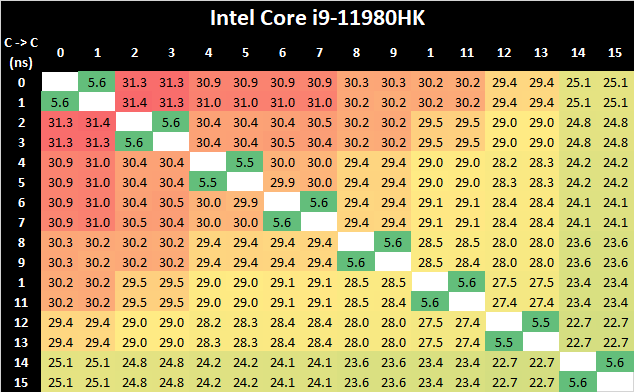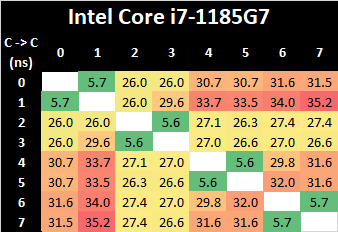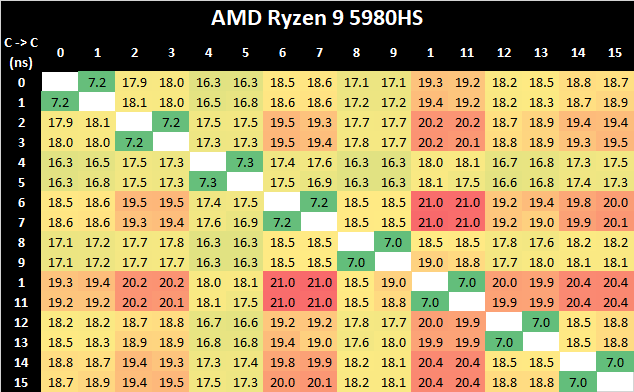Intel 11th Generation Core Tiger Lake-H Performance Review: Fast and Power Hungry
by Brett Howse & Andrei Frumusanu on May 17, 2021 9:00 AM EST- Posted in
- CPUs
- Intel
- 10nm
- Willow Cove
- SuperFin
- 11th Gen
- Tiger Lake-H
CPU Tests: Microbenchmarks
Core-to-Core Latency
As the core count of modern CPUs is growing, we are reaching a time when the time to access each core from a different core is no longer a constant. Even before the advent of heterogeneous SoC designs, processors built on large rings or meshes can have different latencies to access the nearest core compared to the furthest core. This rings true especially in multi-socket server environments.
But modern CPUs, even desktop and consumer CPUs, can have variable access latency to get to another core. For example, in the first generation Threadripper CPUs, we had four chips on the package, each with 8 threads, and each with a different core-to-core latency depending on if it was on-die or off-die. This gets more complex with products like Lakefield, which has two different communication buses depending on which core is talking to which.
If you are a regular reader of AnandTech’s CPU reviews, you will recognize our Core-to-Core latency test. It’s a great way to show exactly how groups of cores are laid out on the silicon. This is a custom in-house test built by Andrei, and we know there are competing tests out there, but we feel ours is the most accurate to how quick an access between two cores can happen.
In terms of the core-to-core tests on the Tiger Lake-H 11980HK, it’s best to actually compare results 1:1 alongside the 4-core Tiger Lake design such as the i7-1185G7:
What’s very interesting in these results is that although the new 8-core design features double the cores, representing a larger ring-bus with more ring stops and cache slices, is that the core-to-core latencies are actually lower both in terms of best-case and worst-case results compared to the 4-core Tiger Lake chip.
This is generally a bit perplexing and confusing, generally the one thing to account for such a difference would be either faster CPU frequencies, or a faster clock of lower cycle latency of the L3 and the ring bus. Given that TGL-H comes 8 months after TGL-U, it is plausible that the newer chip has a more matured implementation and Intel would have been able to optimise access latencies.
Due to AMD’s recent shift to a 8-core core complex, Intel no longer has an advantage in core-to-core latencies this generation, and AMD’s more hierarchical cache structure and interconnect fabric is able to showcase better performance.
Cache & DRAM Latency
This is another in-house test built by Andrei, which showcases the access latency at all the points in the cache hierarchy for a single core. We start at 2 KiB, and probe the latency all the way through to 256 MB, which for most CPUs sits inside the DRAM (before you start saying 64-core TR has 256 MB of L3, it’s only 16 MB per core, so at 20 MB you are in DRAM).
Part of this test helps us understand the range of latencies for accessing a given level of cache, but also the transition between the cache levels gives insight into how different parts of the cache microarchitecture work, such as TLBs. As CPU microarchitects look at interesting and novel ways to design caches upon caches inside caches, this basic test proves to be very valuable.
What’s of particular note for TGL-H is the fact that the new higher-end chip does not have support for LPDDR4, instead exclusively relying on DDR4-3200 as on this reference laptop configuration. This does favour the chip in terms of memory latency, which now falls in at a measured 101ns versus 108ns on the reference TGL-U platform we tested last year, but does come at a cost of memory bandwidth, which is now only reaching a theoretical peak of 51.2GB/s instead of 68.2GB/s – even with double the core count.
What’s in favour of the TGL-H system is the increased L3 cache from 12MB to 24MB – this is still 3MB per core slice as on TGL-U, so it does come with the newer L3 design which was introduced in TGL-U. Nevertheless, this fact, we do see some differences in the L3 behaviour; the TGL-H system has slightly higher access latencies at the same test depth than the TGL-U system, even accounting for the fact that the TGL-H CPUs are clocked slightly higher and have better L1 and L2 latencies. This is an interesting contradiction in context of the improved core-to-core latency results we just saw before, which means that for the latter Intel did make some changes to the fabric. Furthermore, we see flatter access latencies across the L3 depth, which isn’t quite how the TGL-U system behaved, meaning Intel definitely has made some changes as to how the L3 is accessed.














229 Comments
View All Comments
eastcoast_pete - Monday, May 17, 2021 - link
A key question is now if Intel can further improve its 10 nm superfin process in time for Alder Lake. This TL is at least getting somewhat close to AMD's monolithic Zen3, but Rembrandt is around the corner, and that'll be an even more capable competitor. Right now, Intel retains its market share mostly because AMD can't deliver as many CPUs as people would buy.hfm - Monday, May 17, 2021 - link
I'm looking forward to an i5 or i7 design with no dGPU and that sweet embedded TB4. Probably going to be a small subset of the offerings like the lower tier XPS 15/17. Interested to see what comes about later in summer.evilspoons - Monday, May 17, 2021 - link
It'd be helpful to see power-normalized graphs, some of these results are a bit of a double-edged sword.outsideloop - Monday, May 17, 2021 - link
I want to see a comparison of the 11980HK with the 5800X clocked down to 65W, apples to apples. Let's compare the thermals of the AMD 8-core desktop to this "desktop replacement" Intel 8-core.Hifihedgehog - Monday, May 17, 2021 - link
Core i9-11980HK:https://images.anandtech.com/doci/16680/P95-45W_57...
Ryzen 9 5980HK:
https://images.anandtech.com/doci/16446/Power-P95-...
Just to add some further insight on these two charts, here is some breakdown. What ultimately happens is under sustained heavy loads, Ryzen 5000 series can maintain 8 cores at higher sustained clock speeds (~3.7 GHz) with lower power draw (35W). Bear in mind also that Zen 3 has a slight IPC advantage over Tiger Lake, meaning at a lower clock speed, it performs the same or does the same amount of work as Tiger Lake at a higher clock speed. Yet here we are where Ryzen 5000 can clock higher, do even MORE work, and draw less power. Meanwhile, Intel is struggling to reach similar sustained clock speeds (~3.2 GHz) at 45W sustained and it has slightly lower IPC. That is, Ryzen 5000 is ~10% faster clock-for-clock (or in IPC) than Intel's Willow Cove (Tiger Lake 11th Gen), Cypress Cove (Rocket Lake 11th Gen) or Sunny Cove (Ice Lake 10th Gen) which all three share roughly the same IPC amongst the whole trio (link: https://www.guru3d.com/articles_pages/intel_core_i... ). Ryzen 5000's synergy (higher clocks, lower power, higher IPC) sounds like a recipe for disaster for Intel, no? Alder Lake needs to come sooner rather than later if you ask me. Let's just hope Intel is throwing the full weight of their massive workforce of software developers at the problem of Alder Lake's heterogenous architecture because they will certainly need it working smoothly for it to shine.
lmcd - Monday, May 17, 2021 - link
Can we pause to note that MSI delivering bad thermal performance is characteristic of every single one of their laptops, bar none?lmcd - Monday, May 17, 2021 - link
Like, obviously that doesn't solve all the problems here, but how on earth with all the delays TGL-H(45+) got is this the OEM Intel picked?Spunjji - Tuesday, May 18, 2021 - link
It's a very odd choice. But then, didn't they use MSI for the original TGL reference platform too? That one actually outperformed most shipping devices, although IIRC it did so by running the fans at 100% 🤷♂️lmcd - Tuesday, May 18, 2021 - link
I put it on twitter also but my opinion is that the Tiger Lake MSI design is actually about the cooling and size that MSI would use for an H series processor normally, such as the MSI Creator.This implies that the MSI's thermal overhead is pure luck on Intel's part in that MSI didn't have time to reduce the thermal performance accordingly.
Spunjji - Thursday, May 20, 2021 - link
That would make sense!